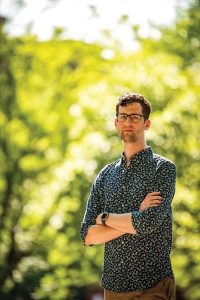
Photo by Ryan Bradenberg
A Lifelong Commitment
As family lore tells it, I started the recycling program at my elementary school. Disgruntled that I had a special place to put paper and plastic at home but not at school, I brought a recycling bin to my second grade classroom and gave a presentation to my class about why it was important to put paper we no longer needed into this special bin so it could be turned into new paper.
A decade later, I started looking at colleges. At the time, Colgate was sporting a C+ rating on its sustainability report card, with its best feature being the Cruiser that transports students up and down the hilly campus. While I was disappointed that my favorite school was not a leader in sustainability, I was hopeful that one day it could be.
My time as a student at Colgate coincided with major sustainability developments on campus. The University hired John Pumilio, the first director of sustainability, and former President Rebecca Chopp had just signed the American College & University Presidents’ Climate Commitment (now called the Second Nature Climate Commitment), which set into motion our pledge to become carbon neutral. Colgate, as an institution, was signaling to its community that it was willing to take sustainability more seriously.
These developments paved the way for my summer internship in the Office of Sustainability. I helped to develop the Green Raider Program, through which other student interns furthered sustainability efforts on campus by promoting green living and organizing events through peer-to-peer interactions. This work enabled me to put some of what I was learning in my environmental studies major into practice.
After graduation, I worked as the environmental studies and sustainability program coordinator for the sustainability office and the environmental studies program. I mentored 13 (of course) of the brightest and most dedicated student interns, who saw the potential to transform Colgate into an institution that embodies an ethos of sustainability. Those interns worked tirelessly to bring their fellow students into a culture of caring for the environment and include sustainability in campus programming — from Recyclemania to the 13 Days of Green.
There was a moment during my time working for Colgate when a donor asked why it was worthwhile to put money toward sustainability initiatives. I see the value of a sustainability program in ways that extend beyond institutional improvements and accomplishments. Sustainability programs provide the opportunity for students hoping to make a difference in the world to see how the material they learn in the classroom can make meaningful change in their own community.
I’m proud of the work we did in the Office of Sustainability while I was there, but it was not until after I left Colgate that I realized its true value: enabling those who care about environmental problems to develop solutions and then take those lessons with them when they leave Hamilton.
I am now earning a PhD in geography at Temple University, and my research explores how we can ensure that parks and green spaces in cities benefit everyone, not just the most privileged. While I had a devotion to environmental issues during my early years, my experience at Colgate catalyzed this passion into a lifelong pursuit.
— Stephen Dickinson ’13 lives in Philadelphia, Pa., with his partner. Dickinson can be easily spotted as the tall man walking down the street carrying his reusable polka dot–patterned grocery bag.
